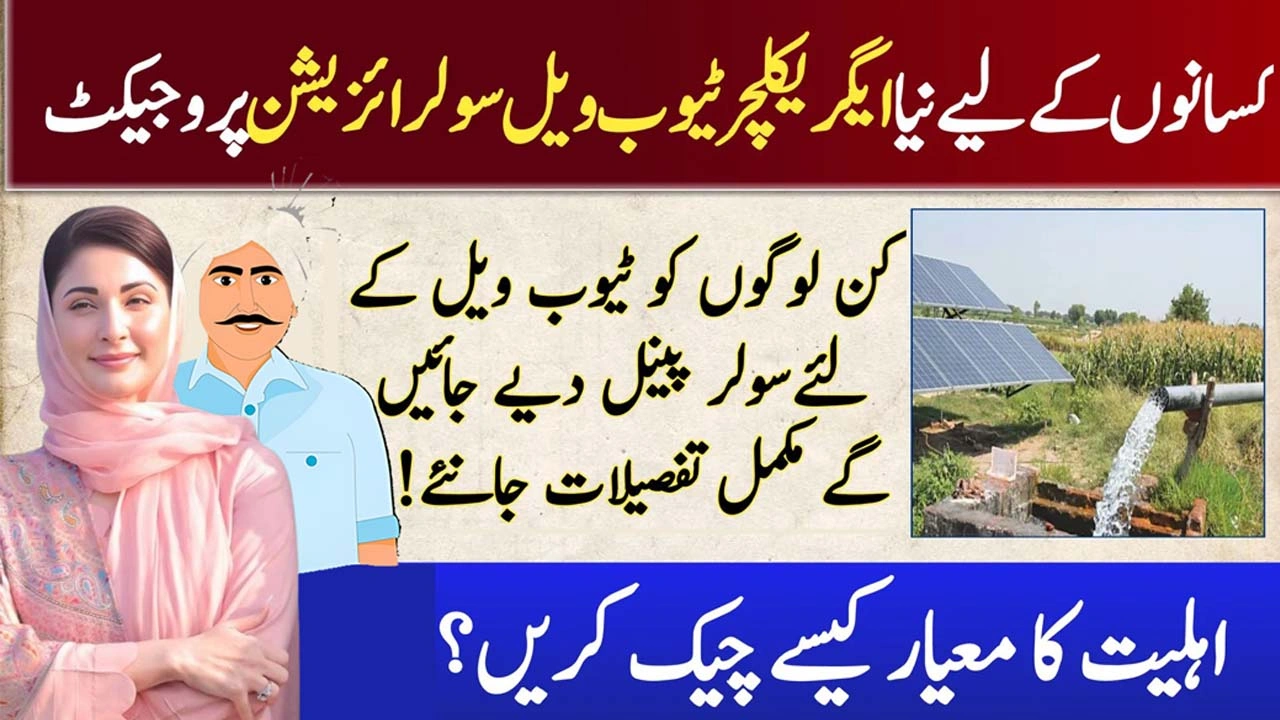Punjab Chief Minister Maryam Nawaz has unveiled a groundbreaking initiative aimed at revolutionizing the agricultural sector— the “Agriculture Tubewell Solarization Project 2025.” This initiative seeks to provide farmers with sustainable and cost-effective irrigation solutions through the use of solar-powered tubewells. By reducing dependence on expensive diesel and electricity, the project promises a greener, more prosperous future for Punjab’s farming community.
Introduction
Punjab is often hailed as Pakistan’s agricultural powerhouse. However, the high cost of diesel and electricity for irrigation has long burdened farmers, affecting their profitability and agricultural output. The newly announced “Agriculture Tubewell Solarization Project 2025” is a step towards solving these challenges. Let’s dive into how this innovative project will transform Punjab’s agricultural landscape.
The Need for Solarization in Agriculture
Farmers in Punjab have faced mounting challenges due to rising fuel and electricity prices. Traditional irrigation methods are not only costly but also environmentally unsustainable. Solarization offers a practical solution by:
- Reducing Costs: Solar energy is a free and abundant resource, eliminating the need for expensive fuels.
- Environmental Conservation: Solar-powered systems significantly lower carbon emissions.
- Reliable Water Access: Solar energy provides a consistent power source, ensuring uninterrupted irrigation.
Also Read: Maryam Nawaz Business Loan Scheme 2025 – Online Registration & Loan Details
Key Objectives of the Project
The primary goals of the “Agriculture Tubewell Solarization Project 2025” are:
- Cost Reduction: Lower irrigation expenses by transitioning to solar energy systems.
- Sustainability: Encourage renewable energy usage to conserve the environment.
- Increased Agricultural Productivity: Ensure reliable and cost-effective irrigation for higher crop yields.
- Financial Empowerment: Enable farmers to allocate saved resources to other agricultural investments.
Notable Features of the Solarization Project

Eligibility Criteria
To participate in this project, farmers must own at least 25 acres of agricultural land.
Financial Assistance
The Punjab government will subsidize 67% of the solarization costs, while farmers will contribute the remaining 33%. This financial model aims to make the transition accessible and feasible for all eligible farmers.
Phased Implementation
The project will be executed in two key phases:
- Phase 1: Solarization of 7,000 tubewells
- Phase 2: Conversion of an additional 10,000 tubewells in collaboration with the federal government
Economic Savings Comparison
Solar energy offers substantial cost savings compared to traditional irrigation methods:
| Irrigation Method | Cost per Acre (PKR) |
|---|---|
| Diesel-Powered | 3,000 |
| Electricity-Powered | 1,500 |
| Solar-Powered | 50 |
These savings will significantly increase farmers’ profitability.
How the Project Will Be Implemented
The government has outlined a clear implementation strategy to ensure smooth execution:
- Application Process: Farmers can apply online through the official portal at cmstp.punjab.gov.pk. Application forms are also available for download.
- Site Assessment: A technical team will conduct site visits to assess water depth and determine the appropriate solar system capacity.
- Installation: Solar systems will be installed with minimal disruption to farmers’ irrigation schedules.
- Training and Support: Comprehensive training will be provided to farmers on system operation and maintenance.
Expected Impact on Punjab’s Agriculture
The successful execution of this project is expected to yield numerous benefits:
- Economic Advantages: Lower irrigation costs will boost farmers’ profitability.
- Environmental Impact: Reduced reliance on fossil fuels will contribute to a greener environment.
- Enhanced Agricultural Output: Reliable irrigation will lead to better crop yields and overall agricultural growth.
Also Read: How to Check CM Solar Panel Scheme Application Status Online – Step-by-Step Guide
Challenges and Possible Solutions
Awareness and Education
Many farmers may be unaware of the benefits of solarization. Awareness campaigns and training programs will be crucial.
Technical Support
To ensure long-term success, the government must provide robust technical support for system maintenance.
Financial Accessibility
Farmers may face difficulties in affording the remaining 33% of project costs. Micro-financing options and low-interest loans could address this challenge.
Conclusion
The “Agriculture Tubewell Solarization Project 2025” spearheaded by CM Maryam Nawaz is a visionary step towards a more sustainable and prosperous agricultural future in Punjab. By reducing costs, promoting environmental conservation, and empowering farmers, this initiative has the potential to revolutionize farming practices in the region. With proper implementation and ongoing support, Punjab is set to become a model of sustainable agriculture in Pakistan.
FAQs
1. What is the goal of the Agriculture Tubewell Solarization Project 2025?
The project aims to reduce irrigation costs, promote renewable energy, and empower farmers by transitioning to solar-powered tubewells.
2. How much financial assistance will the government provide?
The government will cover 67% of the solarization costs, while farmers are responsible for the remaining 33%.
3. Who is eligible for this project?
Farmers owning at least 25 acres of agricultural land are eligible to apply.
4. How can farmers apply for this project?
Farmers can apply online through the official portal at cmstp.punjab.gov.pk or download the application form.
5. What are the expected benefits of this project?
The project is expected to lower irrigation costs, reduce environmental impact, and enhance agricultural productivity in Punjab.

